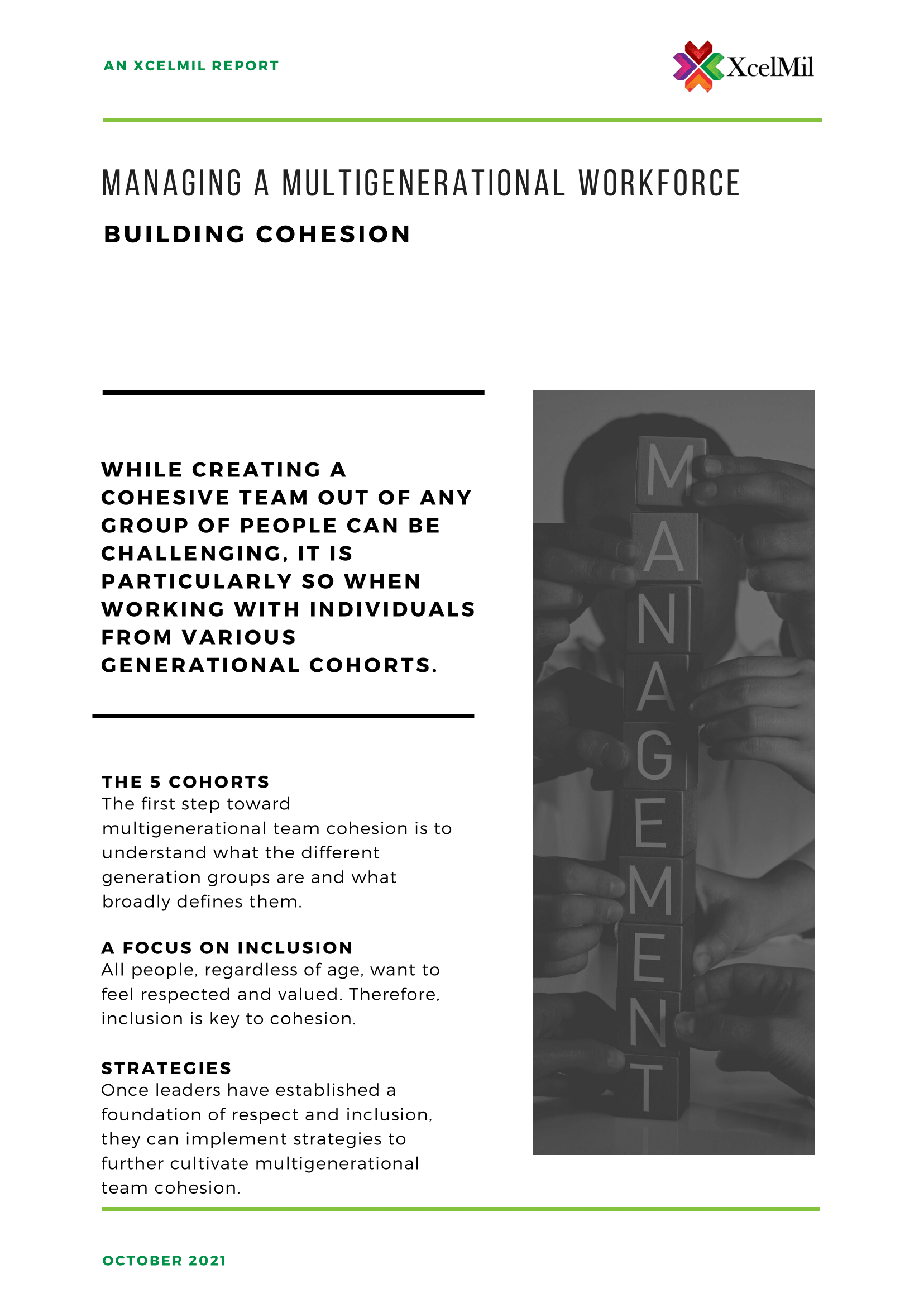
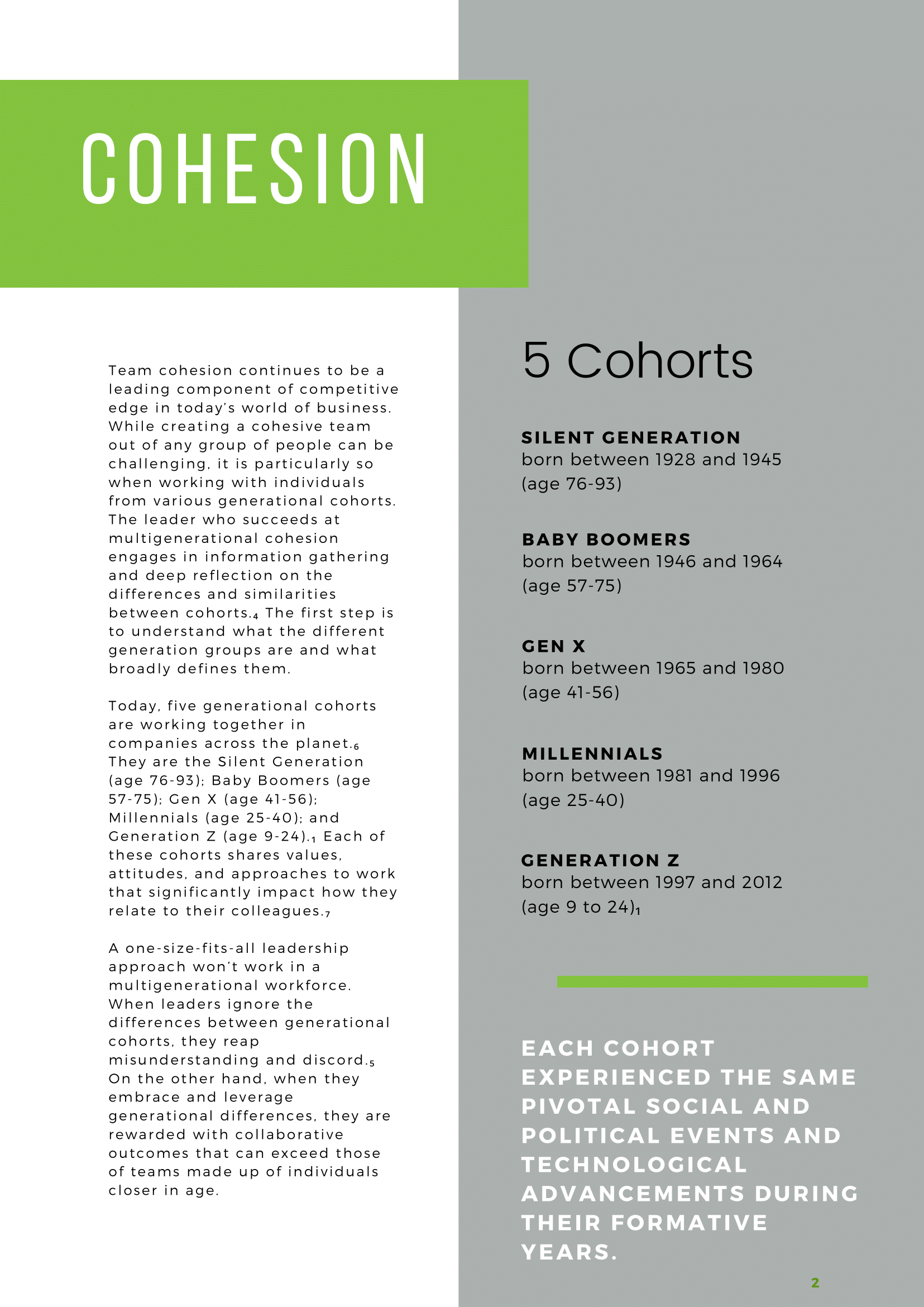
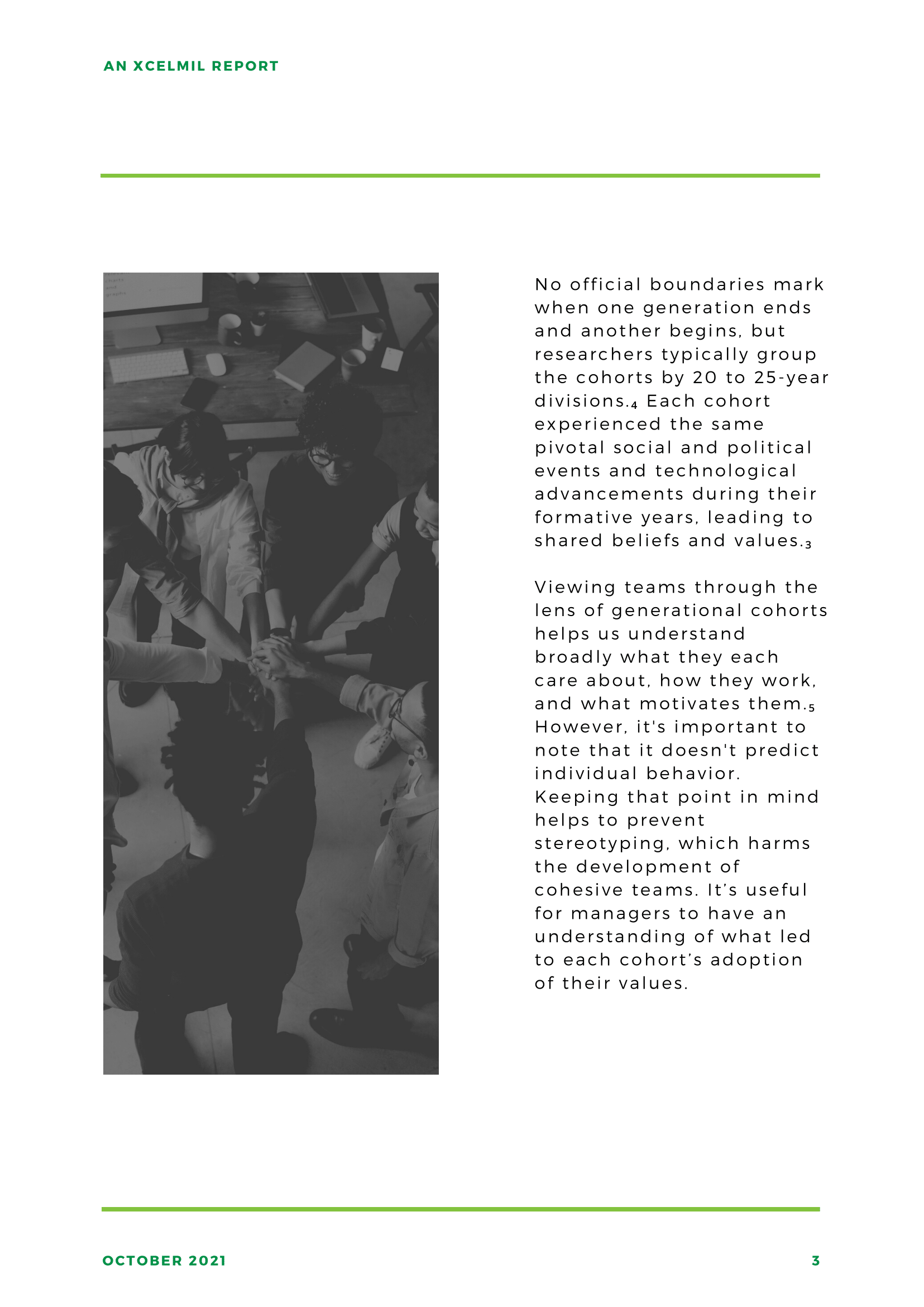
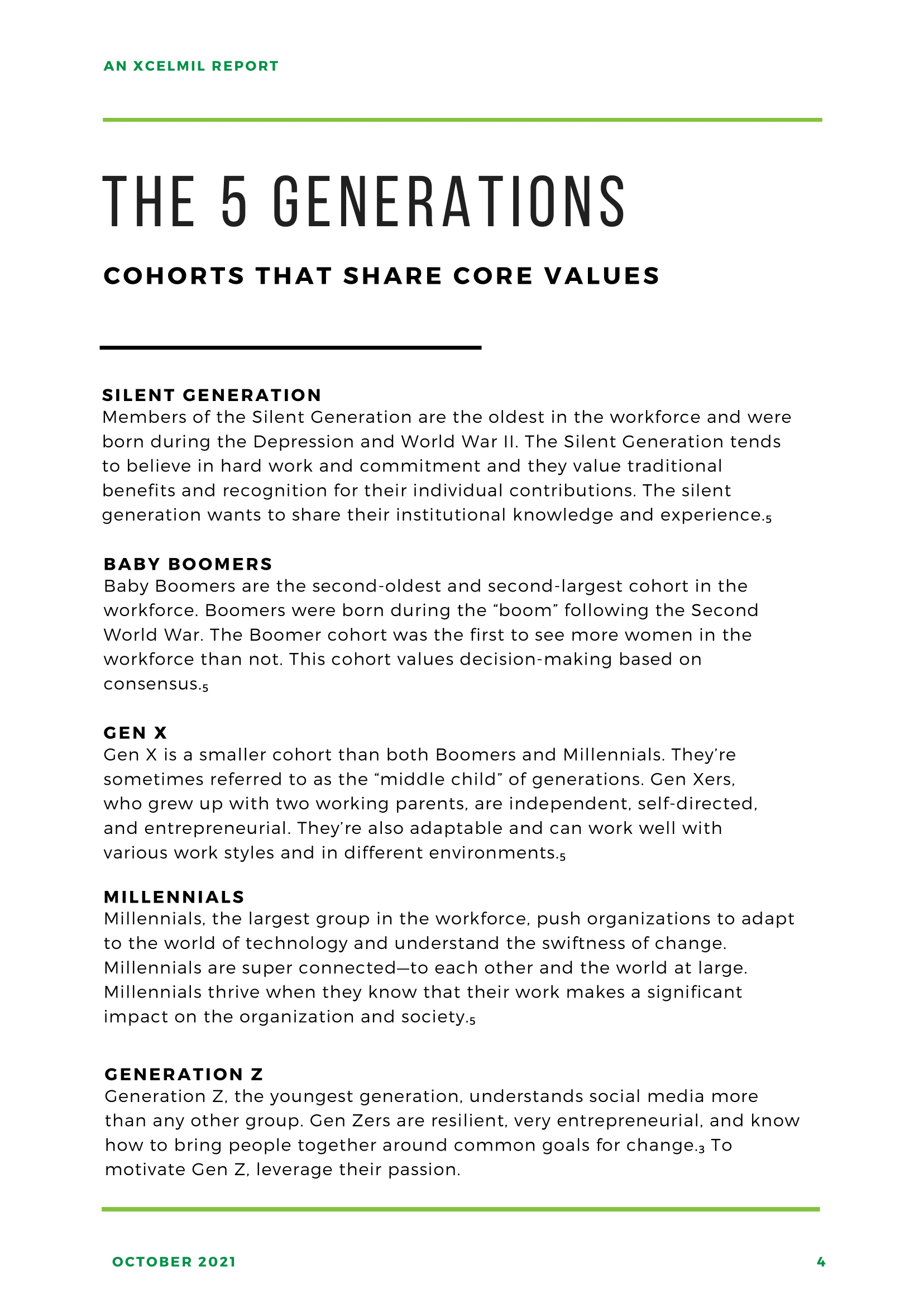
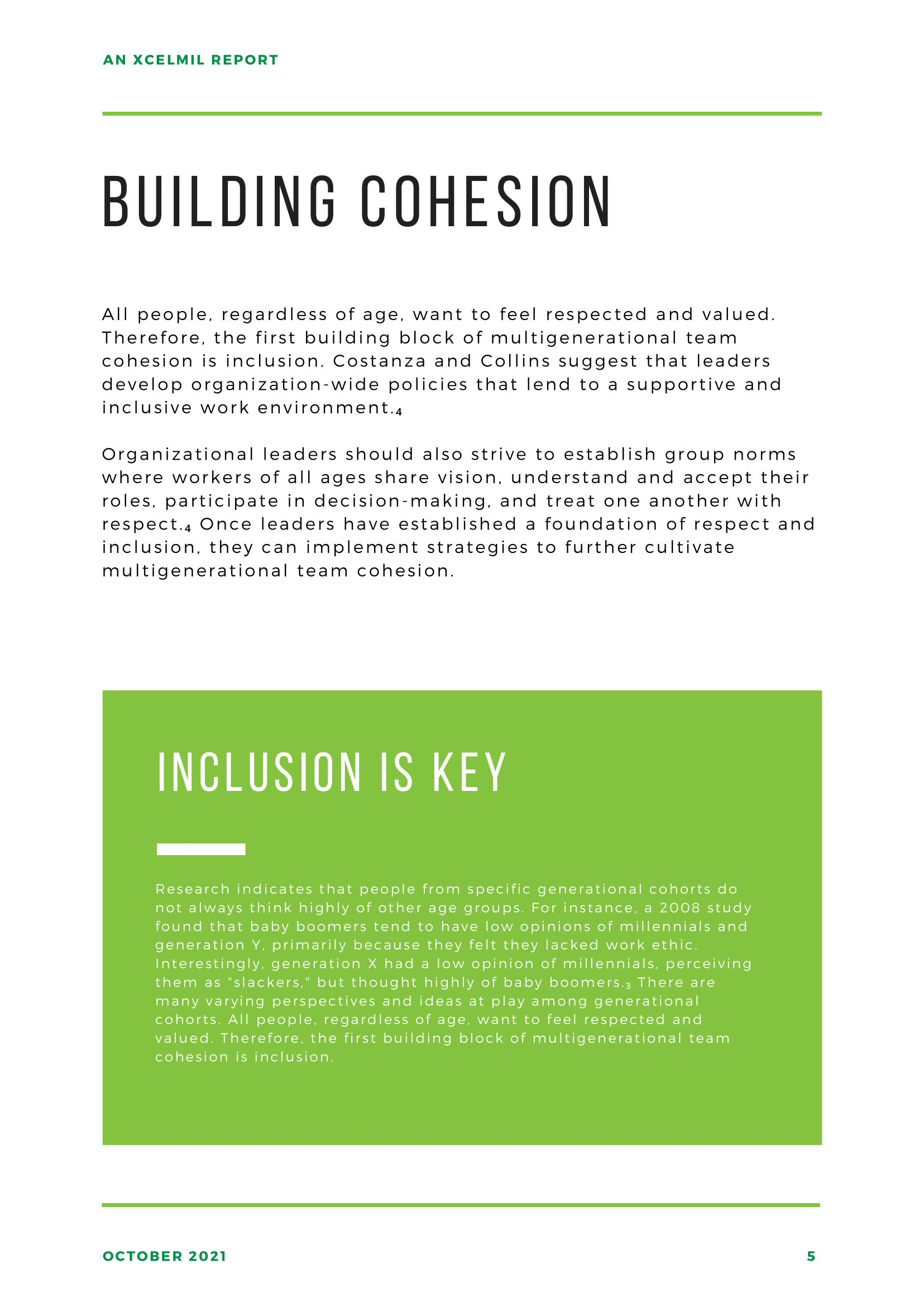
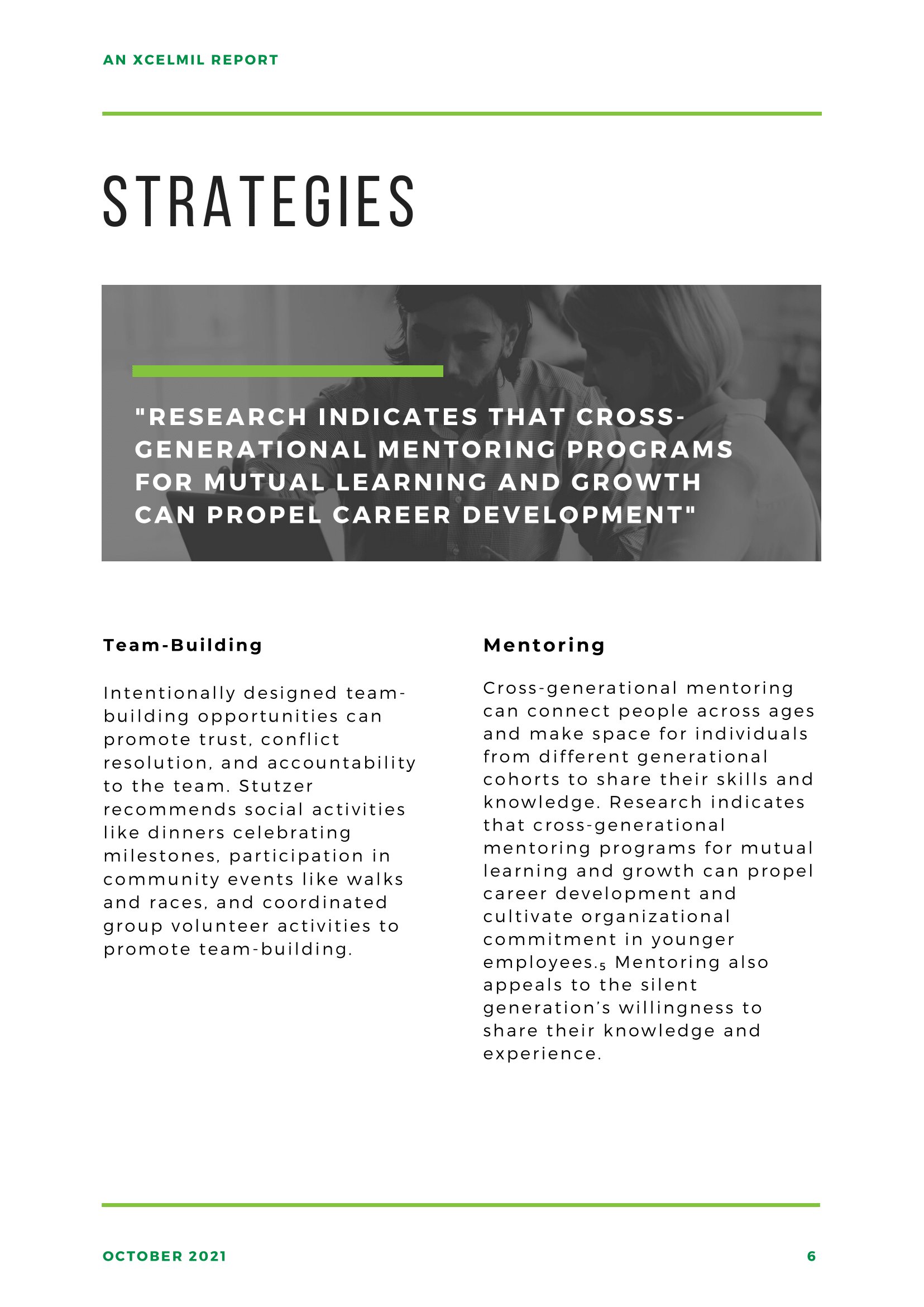
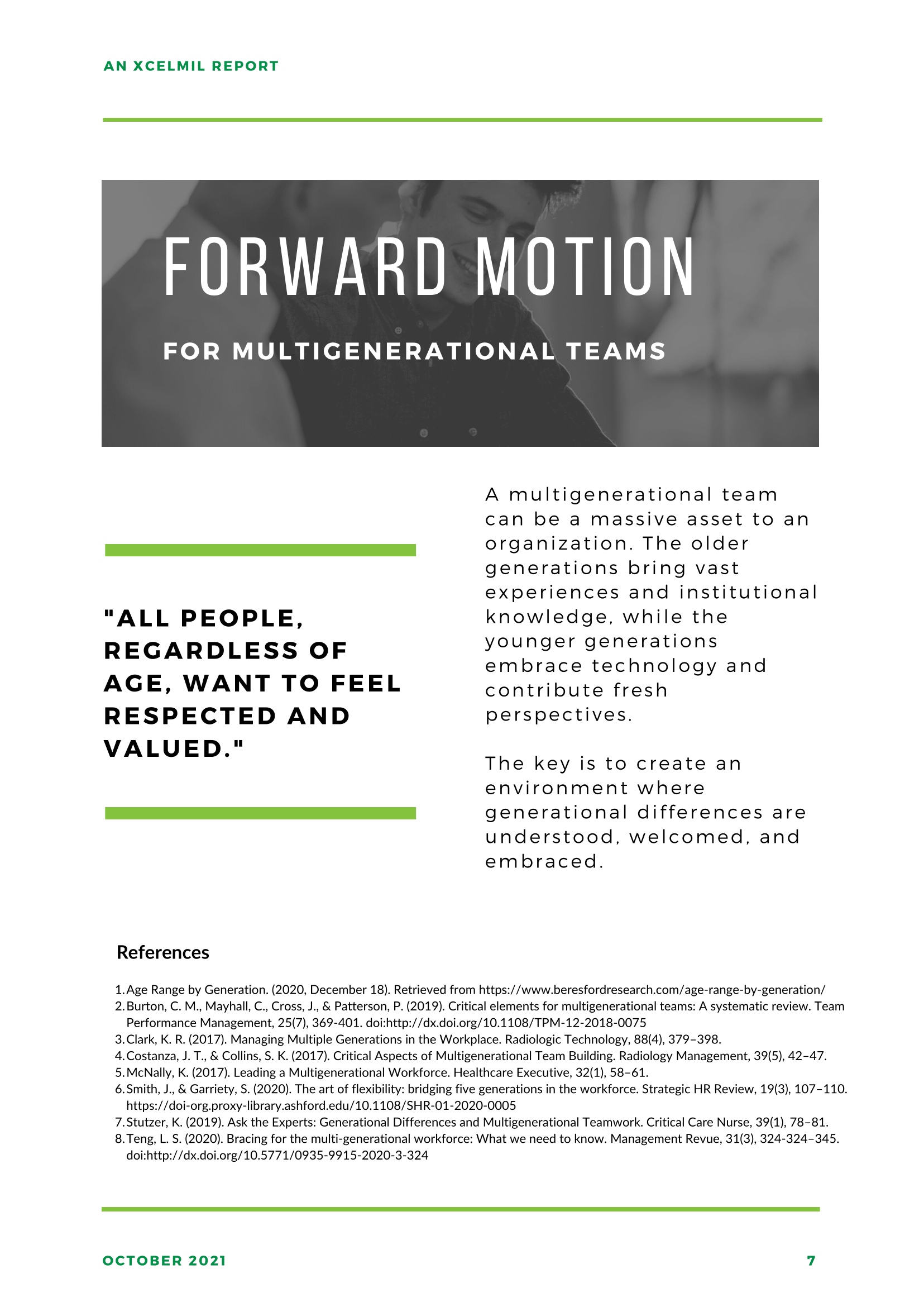



Today, many workplaces have four, or even five, generational cohorts working together in and across teams, making for a complex organizational environment. Fortunately, along with the challenges come huge opportunities for leaders to leverage a diverse set of experiences, skills, and perspectives.
First off, let’s define “generation.” A generation is a group of people who were born and live simultaneously. There’s no formal beginning and end of a generation. You’ve likely heard or read different dates used to describe the boundaries of the five cohorts—the Silent Generation, Boomers, Generation X, Millennials, and Generation Z. However, experts agree that people who grow up around the same time and share pivotal experiences and events tend to share common traits and values. With that in mind, here are three tips to help you make the most of your multigenerational team.
Tip #1: Strive to Understand the Major Differences Between Generations
 The first step to managing a multigeneration team well is to understand generational differences and how they directly impact how your employees work, how they prefer to be recognized, and what they want from their employer. To learn more about the five generational cohorts working today, check out our previous post, Five Generations in the Workforce: A Primer.
The first step to managing a multigeneration team well is to understand generational differences and how they directly impact how your employees work, how they prefer to be recognized, and what they want from their employer. To learn more about the five generational cohorts working today, check out our previous post, Five Generations in the Workforce: A Primer.
Tip #2: Encourage Mutual Understanding and Respect.
 Healthy company culture is one where all employees feel respected, valued, and supported. Unfortunately, research indicates that people from specific generational cohorts do not always think highly of other age groups. For instance, a 2008 study found that baby boomers tend to have low opinions of generation X and Y, primarily because they felt they lacked work ethic. Interestingly, generation X had a low opinion of millennials, perceiving them as “slackers,” but thought highly of baby boomers. There are lots of varying perspectives and ideas at play among generational cohorts. One way to bridge the gap is to create pathways for multigenerations to build connections through mentoring programs.
Healthy company culture is one where all employees feel respected, valued, and supported. Unfortunately, research indicates that people from specific generational cohorts do not always think highly of other age groups. For instance, a 2008 study found that baby boomers tend to have low opinions of generation X and Y, primarily because they felt they lacked work ethic. Interestingly, generation X had a low opinion of millennials, perceiving them as “slackers,” but thought highly of baby boomers. There are lots of varying perspectives and ideas at play among generational cohorts. One way to bridge the gap is to create pathways for multigenerations to build connections through mentoring programs.
Tip #3: Ask for Your Team Members to Share Their Perspectives
 Finally, not all people exhibit the characteristics shared by the generational cohort assigned by their age. For example, when people move up the ladder at work, they might start to embody the next cohort older up from theirs. Others might identify more with another cohort because they spent more time with that age group growing up. In short, individuals are difficult to put into any box. As such, it’s important to remember that everyone is unique and to find ways to hear everyone’s different perspectives so you can create a positive work environment where each person can be successful.
Finally, not all people exhibit the characteristics shared by the generational cohort assigned by their age. For example, when people move up the ladder at work, they might start to embody the next cohort older up from theirs. Others might identify more with another cohort because they spent more time with that age group growing up. In short, individuals are difficult to put into any box. As such, it’s important to remember that everyone is unique and to find ways to hear everyone’s different perspectives so you can create a positive work environment where each person can be successful.
A multigenerational team can be a massive asset to an organization. The older generations bring vast experiences and institutional knowledge, while the younger generations embrace technology and contribute fresh perspectives. The key is to create an environment where generational differences are understood, welcomed, and embraced. We hope the three tips outlined above help you get started toward that vision.
Book a consultation with us now! Please do not hesitate to contact us with any questions. We would love to hear from you. Email at [email protected].
Click here https://xcelmil.com/xcelmil-coaching-and-consulting-services/ to learn more about our services.
XcelMil, LLC is a certified Minority-Woman and Service-Disabled Veteran-Owned Small Business specializing in Executive Management Consulting and Leadership Development Training.

While there are many critical components of successful organizations, the people are undeniably the largest asset of any company. Influential leaders strive to understand their people at every level to motivate and engage them. One essential aspect of understanding and leveraging the experience and talents of the people in an organization is knowing the generational differences that impact skills, work style, and motivation.
What follows is a primer on the five generations in the workforce today, as outlined by Point B Consultants Julie Smith and Susan Garriety. While each generation’s beginning and end birth dates vary slightly by source, we cite dates in this article asserted by Beresford Research.
Silent Generation
 The silent generation is the oldest in the workforce today, born between 1928 and 1945. In 2021, these individuals are between the ages of 76 and 93 years old. While members of the Silent Generation will be exiting the workforce in the coming years, they still play a critical role.
The silent generation is the oldest in the workforce today, born between 1928 and 1945. In 2021, these individuals are between the ages of 76 and 93 years old. While members of the Silent Generation will be exiting the workforce in the coming years, they still play a critical role.
This generation includes Warren Buffet, Bernie Sanders, and our U.S. President, Joe Biden. The Silent Generation values commitment, hard work, traditional benefits, and individual recognition.
The key to engaging this group is to respect their experience and institutional knowledge and make space for them to share their wisdom.
Baby Boomers
 Baby Boomers, the second largest group at work after millennials, were born between 1946 and 1964 and are between 57 and 75 years old. Boomers were born after WWII and brought significant changes to the workforce. They were the first generation ever before to have more women between the ages of 22 and 27 going to work than staying home. To engage Boomers, be sure to involve them in decision-making.
Baby Boomers, the second largest group at work after millennials, were born between 1946 and 1964 and are between 57 and 75 years old. Boomers were born after WWII and brought significant changes to the workforce. They were the first generation ever before to have more women between the ages of 22 and 27 going to work than staying home. To engage Boomers, be sure to involve them in decision-making.
Gen X
 The Gen X generation is smaller than both Boomers and Millennials; they’re sometimes called the “middle child.” This group was born between 1965 and 1980 and is 41 to 56 years old. This generation is flexible, self-directed, independent, and highly entrepreneurial. To engage Gen Xers, tap into their creativity and drive.
The Gen X generation is smaller than both Boomers and Millennials; they’re sometimes called the “middle child.” This group was born between 1965 and 1980 and is 41 to 56 years old. This generation is flexible, self-directed, independent, and highly entrepreneurial. To engage Gen Xers, tap into their creativity and drive.
Millenials
 Millennials, born between 1981 and 1996 (ages 25-40), are the largest group in the workforce. They’ve pushed organizations to adapt to the world of technology and they understand the swiftness of change. Millennials are super connected—to each other and the world at large. To engage millennials, help them understand how their work has a significant impact on the organization and society.
Millennials, born between 1981 and 1996 (ages 25-40), are the largest group in the workforce. They’ve pushed organizations to adapt to the world of technology and they understand the swiftness of change. Millennials are super connected—to each other and the world at large. To engage millennials, help them understand how their work has a significant impact on the organization and society.
Gen Z
 Gen Z, born between 1997 and 2012 (ages 9 to 24), understands social media more than any other group. They are all about bringing people together around common goals for change. Gen Zers are resilient and very entrepreneurial. To engage Gen Z, leverage their passion.
Gen Z, born between 1997 and 2012 (ages 9 to 24), understands social media more than any other group. They are all about bringing people together around common goals for change. Gen Zers are resilient and very entrepreneurial. To engage Gen Z, leverage their passion.
Striving to understand the broad differences between generational groups is the first step toward bridging them together for the organization’s success. The next, and more critical step, is to talk to your employees to grasp further their unique perspectives, values, challenges, and perceived opportunities. Your employees will have invaluable insights about bringing together the work of multiple generations to achieve common goals.
Infographic: 5 Generations in the Workforce: Keys to Engagement
Book a consultation with us now! Please do not hesitate to contact us with any questions. We would love to hear from you. Email at [email protected].
Click here https://xcelmil.com/xcelmil-coaching-and-consulting-services/ to learn more about our services.
Twitter: https://twitter.com/GraticMelody
LinkedIn: https://www.linkedin.com/in/melodygraticconsulting/
XcelMil, LLC is a certified Minority-Woman and Service-Disabled Veteran-Owned Small Business specializing in Executive Management Consulting and Leadership Development Training.

Henry Ford famously said, “Whether you think you can or think you can’t, you’re right.” It turns out this quote is not only inspiring, it’s also true according to decades of empirical research. Constructive thought pattern strategies, including self-talk and mental imagery, are one of the three primary groups of research-based self-leadership strategies. Self-leadership describes one’s ability to motivate and influence themselves.
We all have loops that play over and over in our heads in the background. These loops are both negative and positive, and researchers refer to them as habitual ways of thinking. Specific circumstances trigger these loops, which involve our beliefs, self-talk, and imagined experiences. Self-talk and mental imagery influence one another, essentially creating our thought patterns. By becoming aware of habitual thought patterns that no longer serve us, we can consciously remove them and replace them with constructive thought patterns that lead to better outcomes.
Self-Talk
 Self-talk is what we tell ourselves, whether we’re conscious of our thoughts or not. If you don’t think that you talk to yourself, you are not yet conscious of your self-talk. If you know that you talk to yourself and haven’t done anything to influence the content, you may have noticed how critical and cruel that little voice inside can be.
Self-talk is what we tell ourselves, whether we’re conscious of our thoughts or not. If you don’t think that you talk to yourself, you are not yet conscious of your self-talk. If you know that you talk to yourself and haven’t done anything to influence the content, you may have noticed how critical and cruel that little voice inside can be.
Your self-talk impacts your performance—a 1977 study of 12 gymnasts who were competing for a spot on the men’s U.S.A. Olympic team found that those who made the team practiced intentional self-talk, while those who did not make the team didn’t. Numerous other studies have shown similar outcomes.
The first step in changing your self-talk is becoming aware of current ways of thinking. Try to catch yourself thinking negatively. Perhaps you’ve just finished up a meeting that went poorly, and you find yourself ridiculing your performance (e.g., I should have been more prepared). Then, you can think of a better thought to replace it with (e.g., I learned from this meeting, and I’ll prepare better next time). Once you start regularly noticing your thoughts, it will get easier, and replacing negative thoughts will naturally happen.
Mental Imagery
 Mental imagery is the process of imagining the successful completion of something that hasn’t happened yet. Research indicates that positive mental imagery effectively enhances performance across many arenas and works for people of all types of personalities. When mental imagery is used in sports psychology, a basketball player might visualize themselves sinking shots during the upcoming game in preparation for the actual game.
Mental imagery is the process of imagining the successful completion of something that hasn’t happened yet. Research indicates that positive mental imagery effectively enhances performance across many arenas and works for people of all types of personalities. When mental imagery is used in sports psychology, a basketball player might visualize themselves sinking shots during the upcoming game in preparation for the actual game.
In the professional realm, an organizational leader who has to make a speech at an important event could imagine themselves on stage, giving their speech precisely as they intend to at the actual event.
To practice mental imagery:
Self-talk and positive mental imagery can boost performance for all types of tasks under many different conditions. As a self-leader, by choosing to practice positive self-talk and mental imagery intentionally, you can greatly enhance your performance on various tasks and ultimately achieve your larger goals.
Book a consultation with us now! Please do not hesitate to contact us with any questions. We would love to hear from you. Email at [email protected].
Click here to learn more about our services.
Twitter: https://twitter.com/GraticMelody
LinkedIn: https://www.linkedin.com/in/melodygraticconsulting/
XcelMil, LLC is a certified Minority-Woman and Service-Disabled Veteran-Owned Small Business specializing in Executive Management Consulting and Leadership Development Training.

It’s not challenging to complete enjoyable tasks. For instance, many
of us can browse a clothing store online to buy a new blouse or read the stats from our favorite team’s last game without having to work up any willpower. On the other hand, some tasks, particularly at work, have enjoyable and unpleasant aspects, making them more challenging to get through. That’s where self-leadership, particularly the strategies known as natural rewards, comes in.
Self-leadership is the process of influencing and motivating oneself, and decades of research shows that it enhances productivity, performance, and achievement. Researchers group self-leadership strategies into behavioral-focused, natural reward strategies, and constructive thought pattern strategies. For a complete overview of self-leadership, check out XcelMil’s previous post on self-leadership. In this post, we’re diving into natural reward strategies.
Natural Reward Strategies
 Natural reward strategies aim to help the self-leaders motivate themselves by focusing on an inherently enjoyable task.
Natural reward strategies aim to help the self-leaders motivate themselves by focusing on an inherently enjoyable task.
Natural rewards fall into two sub-categories:
 Natural rewards tie to intrinsic motivation by way of increased competence and self-determination. Task-specific inherent reason directly impacts the task and, in turn, the individual’s overall work performance.
Natural rewards tie to intrinsic motivation by way of increased competence and self-determination. Task-specific inherent reason directly impacts the task and, in turn, the individual’s overall work performance.
Natural rewards increase our attention and efforts, which can make a
specific job more relevant and exciting. When we can complete the tasks that we’ve set out to complete efficiently and effectively, it also helps us feel a greater sense of control over our work.
How to Use Natural Rewards
 So, how does one put self-reward strategies into practice? Here’s your
So, how does one put self-reward strategies into practice? Here’s your
two-part plan.
Step 1: Choose a task you have to complete for work that you’re having
difficulty getting motivated to do. Next, make a mental or physical list of the parts of the work you enjoy. For instance, perhaps you have been dreading putting together your team’s annual sales report. Maybe you identify that you like seeing the growth that your team has achieved over the year or the number of clients that you’ve been able to serve with your product or service successfully. By simply identifying what you enjoy about the work, you should already feel the dread associated with the task start to lift.
Step 2: While working on your task, keep bringing the enjoyable aspects of the work that you identified to the forefront of your mind. When you start to think negatively about the work, redirect your attention to your mental or physical list of pleasant aspects. It may be difficult at first, but it’s like flexing a mental muscle. Whenever you choose to draw your attention back, you’re getting stronger at it, and it will soon get easier.
When employed consistently, natural reward strategies can help you get
more done with less resistance, which will lead to overall better work. At XcelMil, we believe that self-leadership is a powerful tool to achieve more at a higher quality and improve your team’s performance. Contact us today to book a consultation to learn more about what we have to offer around self-leadership.
Book a consultation with us now! Please do not hesitate to contact us with any questions. We would love to hear from you. Email at [email protected]. Click here to learn more about our services.
Twitter: https://twitter.com/GraticMelody
LinkedIn: https://www.linkedin.com/in/melodygraticconsulting/
XcelMil, LLC is a certified Minority-Woman and Service-Disabled Veteran-Owned Small Business specializing in Executive Management Consulting and Leadership Development Training

Belonging is one of the deepest human needs. Everyone in the world desires to find a place where they can experience at least a sense of belonging. They will search for that place or that feeling until they do.
Which brings us to one of the biggest shifts in the workforce we’ve ever seen. If you’re in any kind of executive or management position, you’ve probably heard the phrase “The Great Resignation” by now.
If you haven’t, you can read more about it here.
The fact that four million people quit their jobs in April might have you worried about the future of your team. What will it look like in six months? Are your most talented team members going to bolster the statistics of this great resignation? How can you keep your top talent on your team?
The articles covering The Great Resignation reference things like higher pay, more time with family, and freedom. Workers are leaving their jobs because they are discovering that their work doesn’t align with their real values.
The COVID-19 lockdowns and shifts to remote work gave America’s, and the world’s, workforce the opportunity to do some soul searching. They realized that the way we’ve approached work and life in the modern era has grown stale. They’ve discovered that 50-60 hour weeks and missing family gatherings doesn’t have to be the norm.
They’ve seen a new reality and want to move forward into it. And they aren’t wrong for wanting to do so.
However, where does that leave you? How can you move into the new reality with the workforce? How do you convince your team to continue being your team?
Can you pay higher wages? Maybe you can, and maybe you can’t.
Can you offer more PTO? Possibly.
What can you do if neither of these (or any of other things post-COVID employees want) are viable options?
I believe that The Great Resignation is a sign of the deeper human need of belonging. Workers want more time with the people who make them feel as if they belong: their family and their friends. They want the freedom to pursue their own passions. They want to fulfill their own visions.
What do four million resignations signify?
That workers don’t feel as if they belong at their jobs. If the need for belonging was being met at work, they would not feel the desire to leave as strongly. If they felt they believed in the vision of the organization, they wouldn’t be as quick to leave to pursue their own.
It goes back to the famous management quote “People don’t quit jobs.
They quit bosses.”
So, as a leader, you need to be asking yourself the questions, “What can I do to create belonging on my team?” “How can I help my team align with the vision of the company?”
I think a simple strategy to achieve both is to invest in your team.
Belonging and alignment are created where growth is achievable.
We stay in the relationships that allow us to grow and change without losing the approval of the other person.
We go to the gym and get in better shape because the environment has been cultivated to encourage growth and change.
Leaders need to realize that they set the culture for their organizations and the teams inside them. That means you have the opportunity to build a culture where you encourage the growth and advancement of everyone on your team.
This is no longer just an opportunity. In the face of The Great Resignation, it has become a necessity.
So, I ask you, what are you doing to encourage the growth of your team members? How are you cultivating an environment of belonging?
Both of these questions are answered by how much you are willing to invest in your team.
What resources have you made available to them?
At XcelMil, we understand that employees are human, and we seek to meet the human needs of growth and belonging through an extensive library of continuing education courses.
You can view our selection of courses here.
Sincerely,
The XcelMil Team
Book a consultation with us now! Please do not hesitate to contact us with any questions. We would love to hear from you. Email at [email protected].
Click here https://xcelmil.com/xcelmil-coaching-and-consulting-services/ to learn more about our services.
Twitter: https://twitter.com/GraticMelody
LinkedIn: https://www.linkedin.com/in/melodygraticconsulting/
XcelMil, LLC is a certified Minority-Woman and Service-Disabled Veteran-Owned Small Business specializing in Executive Management Consulting and Leadership Development Training.

Self-leadership (SL) is the process of directing and motivating oneself to succeed, which is a critical part of overall leadership. Obviously, if you can’t get things done and do them well, how can you motivate anyone else?
Decades of research tie self-leadership to performance and achievement by means of specific behavioral and cognitive strategies. Experts typically group these strategies into three categories: behavioral-focused, natural reward, and constructive thought patterns.
For a more in-depth overview of self-leadership, check out our previous post. The purpose of this post and the two that will follow is to deep-dive into each group of strategies that support self-leadership and provide practical tips. First off: behavioral-focused techniques.
Behavioral-focused strategies encourage a sense of responsibility and control that lead to better outcomes. Generally, they support positive, desired behaviors that facilitate positive outcomes and cut down behaviors that give us unwanted results. Behavioral-focused strategies are especially critical for tasks and projects that the self-leader considers less than pleasant. They include self-observation, self-goal setting, self-cueing, self-punishment & self-rewarding.
Self-Cueing
 We are visual beings (yes, you and me). In fact, 90% of our perceptions of the world come from what we see, and that’s why self-cues work so well to motivate us. Self-cues are physical reminders that can keep us focused on our goals and performance. These contextual prompts include inspirational posters, vision boards, reminder notes, posted affirmations, and a pleasing work environment. If you haven’t spruced up your office in a while or experimented with written affirmations, it’s time to give it a try.
We are visual beings (yes, you and me). In fact, 90% of our perceptions of the world come from what we see, and that’s why self-cues work so well to motivate us. Self-cues are physical reminders that can keep us focused on our goals and performance. These contextual prompts include inspirational posters, vision boards, reminder notes, posted affirmations, and a pleasing work environment. If you haven’t spruced up your office in a while or experimented with written affirmations, it’s time to give it a try.
 The second component of the behavioral strategies for self-leadership is self-goal-setting. Goal-setting experts assert that we are biologically designed to set goals for ourselves. To live is a process that depends on action; if we did nothing, we would die. The self-leader sets and attains goals not just to survive but to thrive. Do you have a specific goal toward which you’re actively working?
The second component of the behavioral strategies for self-leadership is self-goal-setting. Goal-setting experts assert that we are biologically designed to set goals for ourselves. To live is a process that depends on action; if we did nothing, we would die. The self-leader sets and attains goals not just to survive but to thrive. Do you have a specific goal toward which you’re actively working?
Self-Reward & Punishment
 The next group of behavioral strategies for self-leadership is self-reward and punishment. Let’s first clarify that the self-punishment aspect is meant to entail learning from one’s experiences, achieving greater understanding, and incorporating self-feedback. There is no place for harsh self-criticism in SL. Self-rewards for goal attainment or a job well done can be intrinsic or extrinsic. If a mental pat on the back is all you need to celebrate an achievement, great. If a massage sounds better, by all means, indulge.
The next group of behavioral strategies for self-leadership is self-reward and punishment. Let’s first clarify that the self-punishment aspect is meant to entail learning from one’s experiences, achieving greater understanding, and incorporating self-feedback. There is no place for harsh self-criticism in SL. Self-rewards for goal attainment or a job well done can be intrinsic or extrinsic. If a mental pat on the back is all you need to celebrate an achievement, great. If a massage sounds better, by all means, indulge.
Finally, self-observation means to reflect and identify unhelpful thoughts and behaviors. We’ll dig further into self-observation in the next blog post, which will focus on developing constructive thought patterns for self-leadership. Behavioral-focused self-leadership strategies bring out the best in us to achieve our desired result while downplaying the negative behaviors that have sabotaged us in the past. Try out the strategies above and let us know if they’ve worked for you. We’d love to hear it.
Book a consultation with us now! Please do not hesitate to contact us with any questions. We would love to hear from you. Email at [email protected].
Click here https://xcelmil.com/xcelmil-coaching-and-consulting-services/ to learn more about our services.
Twitter: https://twitter.com/GraticMelody
LinkedIn: https://www.linkedin.com/in/melodygraticconsulting/
XcelMil, LLC is a certified Minority-Woman and Service-Disabled Veteran-Owned Small Business specializing in Executive Management Consulting and Leadership Development Training.

Self-leadership, in essence, is what it sounds like—the ability to lead oneself. Self-leadership is the process of influencing one’s self, which is a critical part of overall leadership. Before a leader can get other people on board with a big project or initiative, they must direct and motivate themselves to get started.
The topic of self-leadership, while currently popular, is not new. The concept emerged in the mid-1980s and has since earned the respect of academics and business executives alike, serving as the topic of countless research studies, articles, books, and workplace training programs. Self-leadership is a mainstay in the leadership conversation for good reasons, as it provides numerous benefits to individuals and organizations.
Why is self-leadership important?
First, and most obvious, we can each become better leaders by understanding and practicing self-leadership. We can also help develop self-leadership in others so that our teams are more effective. Finally, we can help cultivate self-leadership in individuals who may potentially hold leadership roles in our organization, increasing the likelihood of their success.
The importance of cultivating self-leadership in others becomes apparent when considering the following point. According to research, the best predictors of who will get leadership roles are personal characteristics. Extraversion, dominance, agreeableness, and narcissism are attributes that often predict who will emerge as leaders. If we can start to develop self-leadership in individuals who aren’t dominant or narcissistic but demonstrate real leadership potential, we can cultivate more robust leadership pipelines for our organizations.
How can we become better self-leaders?
Leading academics on self-leadership outline three specific behavioral and cognitive strategies that enhance personal effectiveness:
behavioral-focused strategies, natural reward strategies, and constructive thought pattern strategies.
Behavioral-focused strategies facilitate positive, desired behaviors that support positive outcomes while cutting down on negative behaviors that can lead to unwanted results. These strategies involve self-observation, self-goal setting, self-cueing, self-punishment (to an extent), and self-rewarding.
Natural reward strategies aim to create circumstances where the self-leader is motivated or rewarded by the parts of an inherently enjoyable task. There are two primary sub-strategies associated with natural rewards strategies. The first involves building in more pleasant aspects of a job so that the task itself becomes more enjoyable and rewarding. The second consists of maintaining one’s focus on the more rewarding aspects of the task rather than focusing on unpleasant elements. Both of these sub-strategies enhance competence and self-determination, which tie to intrinsic motivation.
Finally, constructive thought pattern strategies involve confronting and replacing old, detrimental ways of thinking with better ones. Constructive thought pattern strategies also include mental imagery and positive self-talk.
Ongoing leadership success largely depends on one’s ability to self-lead. By implementing the behavioral and cognitive strategies discussed here, we can become more effective leaders for our teams and teach our employees strategies to do their jobs more effectively. We can also develop a leadership pipeline that sees our organizations through to even greater future success.
Book a consultation with us now! Please do not hesitate to contact us with any questions. We would love to hear from you. Email at [email protected].
Click here https://xcelmil.com/xcelmil-coaching-and-consulting-services/ to learn more about our services.
XcelMil, LLC is a certified Minority-Woman and Service-Disabled Veteran-Owned Small Business specializing in Executive Management Consulting and Leadership Development Training.

You have a goal in mind, but that’s all you have. Creating, working towards, and reaching goals is not easy. The journey is often different for everyone. However, there are three parts to achieving every goal that is always the same. Defining the 3 W’s of your goal will allow you to work toward it without losing sight of the big picture.
What do you want? What is your goal? You need to be specific: I want to run a half marathon. I want to write a novel. Explicitly, naming your goal and writing it out will give power to it and will allow you to mentally focus on what you are trying to achieve. Clearly defined goals are easier to work towards. Writing out your target has the added benefit of making the goal “real,” as opposed to a foggy idea floating in your mind.
When do you want to achieve your goal? What is your timeframe? Once you have an overall time frame, you can dive into the milestones that you will need to hit along the way and put time limits on those. Doing this will give you benchmarks on which you can measure your progress. Measuring your progress in increments will also keep your spirits up when you are in the muck of the middle. You will be able to look back and say, “I’m halfway there.”
Why is this your goal? Why do you want to do it? Your why is your everything. Your reasoning should be personal and not something you will be easily swayed from. If you’re going to run a half marathon merely for the glory, you may want to dig a little deeper. Running a half isn’t easy, and in the middle of every training session, it will just be you and your legs. Having a strong why will also come in handy when you lack external support. Having a reliable support system of family and friends makes achieving any goal easier, but sometimes you won’t have that backing.
You have your what your when, and your why. Write down each of these and revisit the W’s when times get tough. You should especially revisit your why daily. It will remind you why you started, why you are continuing, and what awaits you at the end of your long journey. Setting and achieving goals is not for the weak of heart, but if your heart is in it, the process will be much less daunting.
Book a consultation with us now! Please do not hesitate to contact us with any questions. We would love to hear from you. Email at [email protected].
Click here https://xcelmil.com/xcelmil-coaching-and-consulting-services/ to learn more about our services.
Twitter: https://twitter.com/GraticMelody
LinkedIn: https://www.linkedin.com/in/melodygraticconsulting/
XcelMil, LLC is a certified Minority-Woman and Service-Disabled Veteran-Owned Small Business specializing in Executive Management Consulting and Leadership Development Training.

An ideal workplace should be a relaxed and productive atmosphere filled with creativity, support, compassion, excellent communication, and positive values. However, many fall short of this because of Micromanaging. Micromanaging can create a toxic environment.
What is Micromanaging?
Micromanaging is over-management and an inability to delegate.
According to Oxford Languages, “micromanaging control every part, however small, of (an enterprise or activity).”
What does Micromanaging Look Like?
The negative impacts of micromanaging are so intense that it is labeled one of the top reasons employees resign.
Here are the 9 Ways Micromanaging can Negatively Impact Employees:
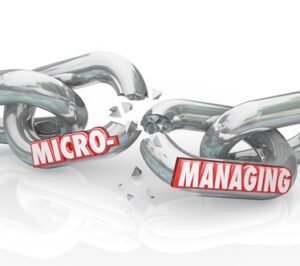
How to Avoid Micromanaging

Managing people is one of the hardest things a leader can do. When employees are given clear direction and the necessary room to run, you’ll be amazed by what can be achieved.
Book a consultation with us now! Please do not hesitate to contact us with any questions. We would love to hear from you. Email at [email protected].
Click here https://xcelmil.com/xcelmil-coaching-and-consulting-services/ to learn more about our services.
XcelMil, LLC is a certified Minority-Woman and Service-Disabled Veteran-Owned Small Business specializing in Executive Management Consulting and Leadership Development Training.